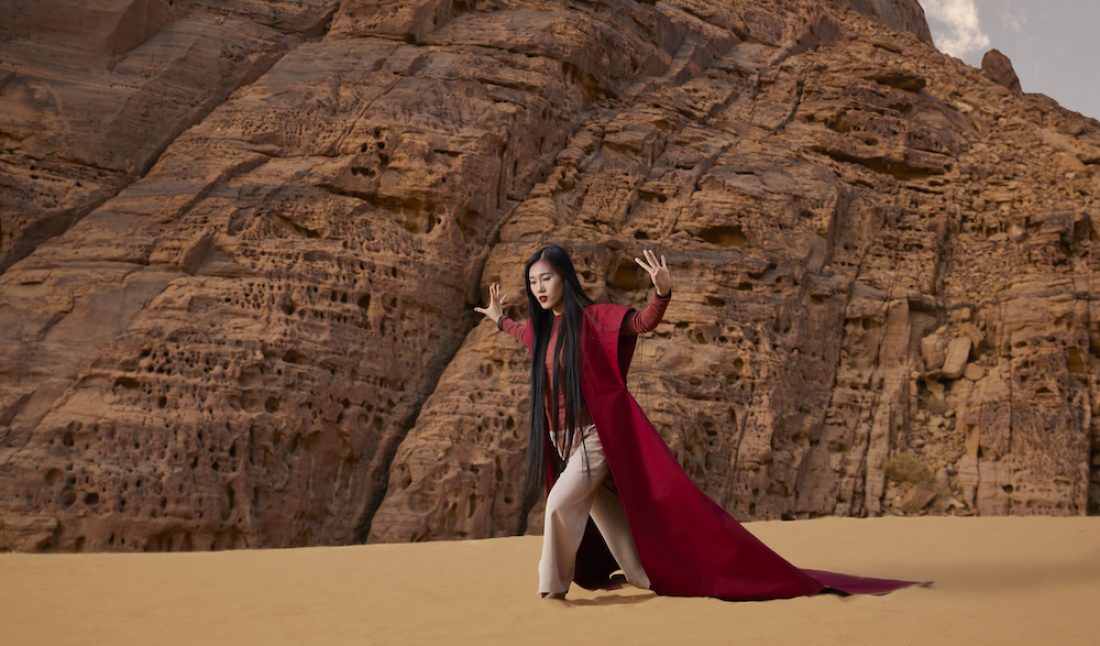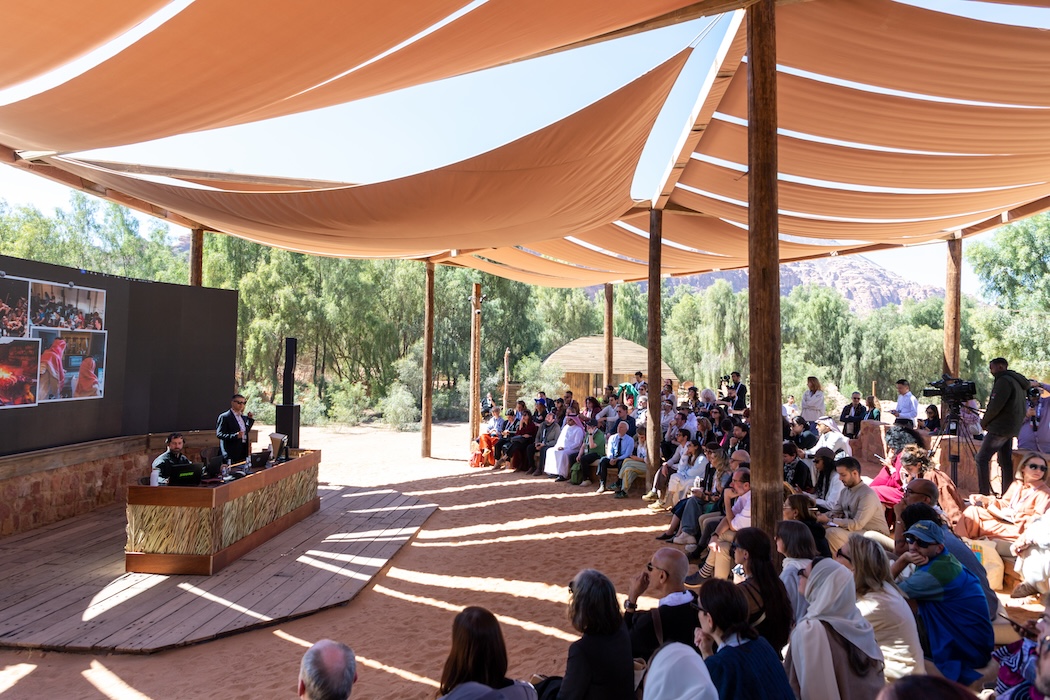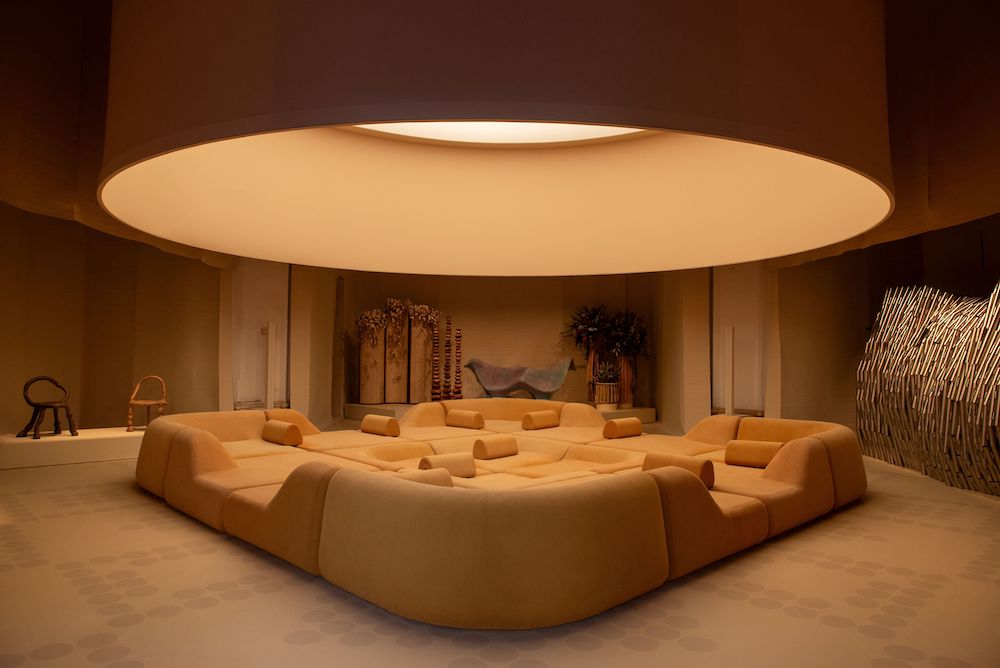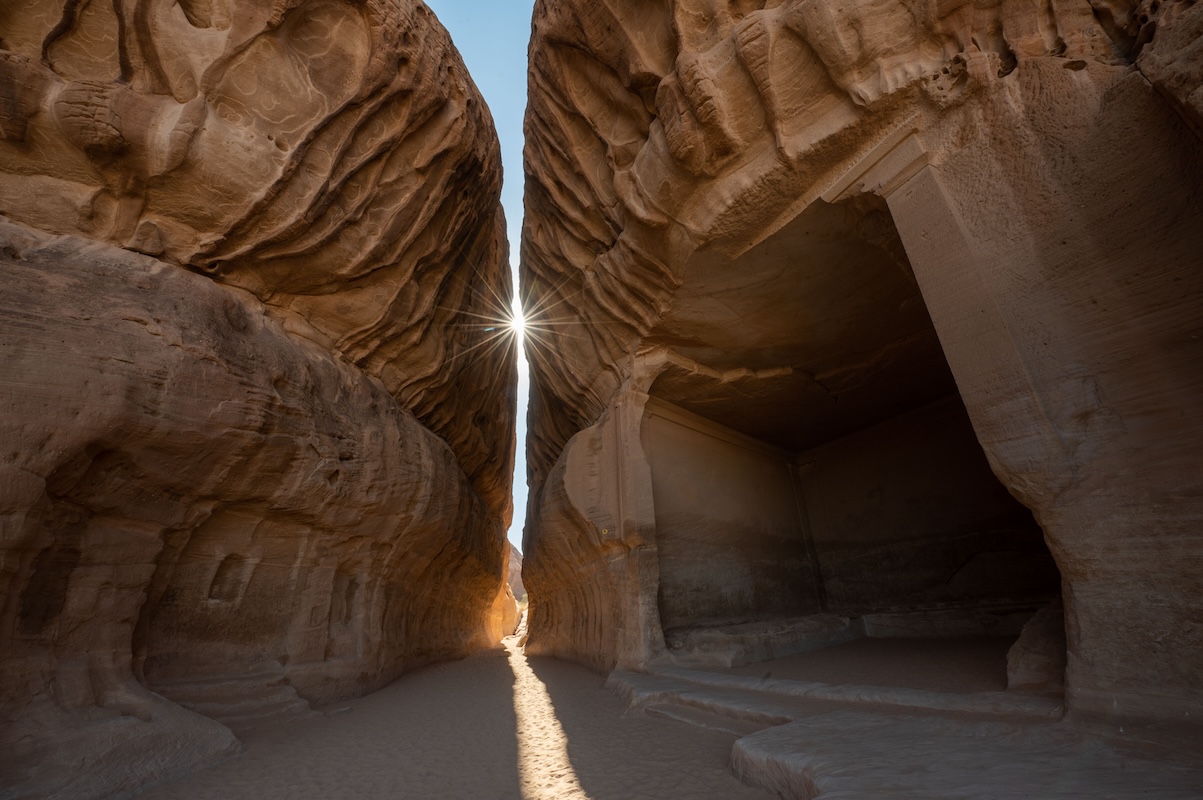The site of Wadi AlFann sits across a 65 kilometers canvas of breathtaking dunes, terracotta cliffs, undulating vistas, and sandstone canyons in the north-western region of Saudi Arabia. There, the Royal Commission of AlUla recently invited artists from Saudi and beyond to respond to the surroundings with site-specific installations. Translating to “Valleys of the Arts,” Wadi AlFann, curated by former Whitechapel Gallery director Iwona Blazwick, will accentuate the beauty of the desert—immersing art in dialogue with nature with the commission of five large-scale site-responsive works from some of the foremost pioneers of environmental and contemporary art of our time: Michael Heizer, James Turell, Agnes Denes, Ahmed Mater, and Manal Al Dowayan.
Asked to conceive pieces that would perdure for generations in tandem with the desert landscape, the five artists draw inspiration from the region’s monumental terrain, ancient histories, and the local community. Historically placed along the famous incense trading route running from Southern Arabia into Egypt, the region has homed 7,000 years of successive civilizations, serving as a crossroads of ancient civilizations, housing both the capitals of the Dedan and Liyhan kingdoms and the ancient Nabataean city and UNESCO heritage site of Hegra.
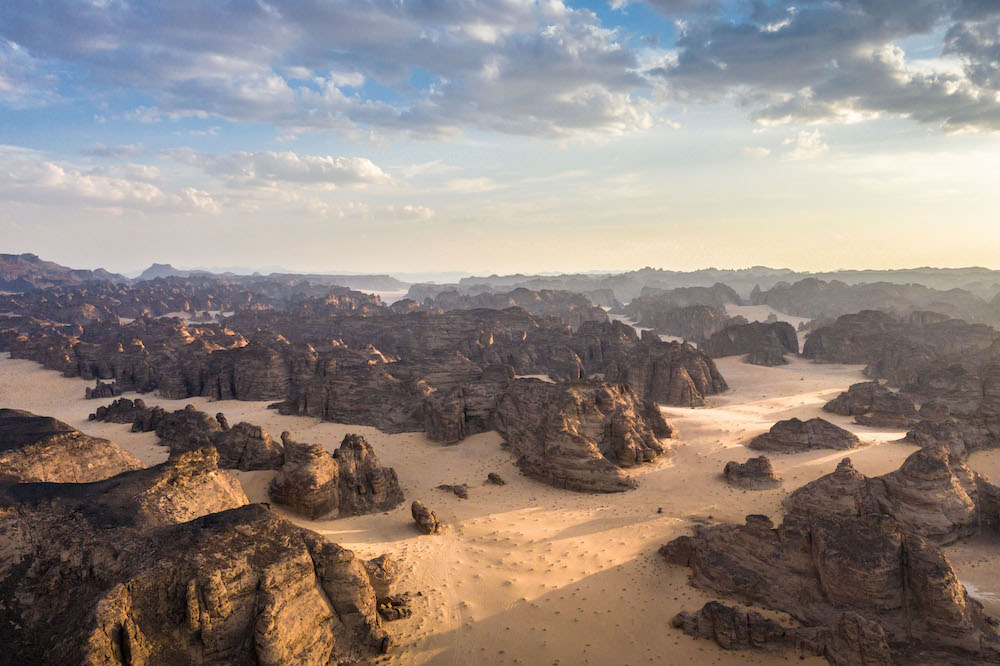 Wadi AlFann, AlUla, courtesy of the Royal Commission for AlUla.
Wadi AlFann, AlUla, courtesy of the Royal Commission for AlUla.
In anticipation of the 2024 unveiling of the first five commissions, with more to come over the next several years, the Royal Commission for AlUla (RCU) held a two-day event last November that included the premiere of the site-responsive theatrical performance “Nine Songs” by Chinese vocalist Rui Fu. The piece brought together a cohort of world-class performers to a circular stage at sunset amidst the desert landscape. An improvisational and impressionistic interpretation of Chinese ethnic and musical traditions, “Nine Songs” promoted the commonality of rituals and practices between cultures and the use of nature as a catalyst between them.
With the hushed desert serving as ambiance, we spoke to Blazwick about Fu’s performance, and how the commissioned artwork installation of Wadi AlFann will come to reflect the beauty of the desert site.
WHITEWALL: Rui Fu’s “Nine Songs” was inspired by an anthology of romantic Chinese poetry from the 1st century BC, acting as a prayer to the clouds, mountains, and rivers, and responding to the very landscape that makes up the canvas of Wadi AlFann. What drew the RCU to the work of this artist and what parallels can we expect to find within the large-scale commissions that are to be permanently placed in Wadi AlFann?
IWONA BLAZWICK: Well, with the great heritage of different civilizations that have left their mark here, the landscape has gathered the traces of pilgrims, traders, explorers, all sorts of different people through hieroglyphs or architecture, and, in the spirit of that, we looked at international practitioners who would bring the world to AlUla, and take traditional forms and reinvent them.
If you look at a lot of contemporary art from the region, it takes calligraphy as its starting point and transcends the semantics of language to something more abstract, something more universally understandable. I think this performance did exactly that. She takes forms from ancient Chinese poetry and then makes it into something very 21st century, very contemporary, locking it into this extraordinary context.
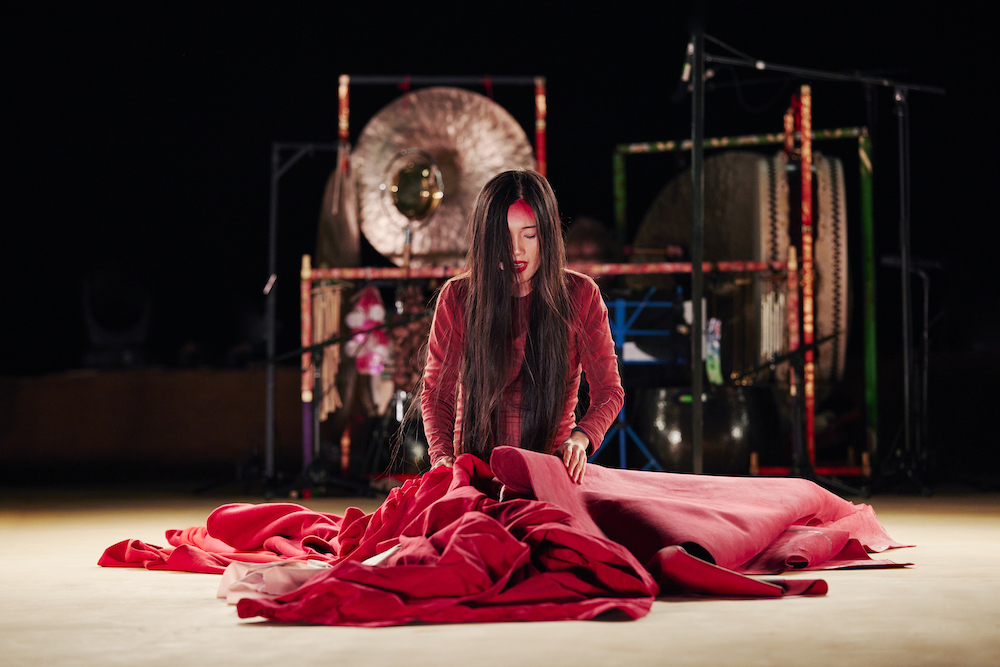 Rui Fu performs in the world premiere of Nine Songs, presented by Wadi AlFann, courtesy of Royal Commission for AlUla.
Rui Fu performs in the world premiere of Nine Songs, presented by Wadi AlFann, courtesy of Royal Commission for AlUla.
Wadi Al Fann used to be under the Red Sea. It’s a huge, bottom of an ocean. And when the waters receded, they left behind these extraordinary cliffs, sandstone stacks, which were shaped by the wind over millennia. This idea about the past in the present is something that informed Rui’s work, allowing the acoustics of the canyon and the presence of natural forces like the wind and the geology of the region to play a part in the performance.
It’s also very dedicated to the concept of site-specificity, in relation not only to the physical environment, but also to the local communities of the ecosystems, the flora, and the fauna. Until the mid-20th century, a lot of society regarded deserts as wastelands, places that were hostile, and empty.
If you look at maps of America, there are whole areas designated “badlands” just because they couldn’t be cultivated. In the sixties and seventies artists began to be drawn to those regions, and the whole phenomena of land and environmental art started. There are extraordinary works by Michael Heizer or Nancy Holt’s Sun Tunnels, and Robert Smithson’s Spiral Jetty in the Salt Lake of Utah in places that were remote, hostile, and existed really only in their imagination. Many people have never visited these great works, so they’ve become legendary. And, that’s also something that has really inspired us in the commissioning approach of Wadi Al Fann.
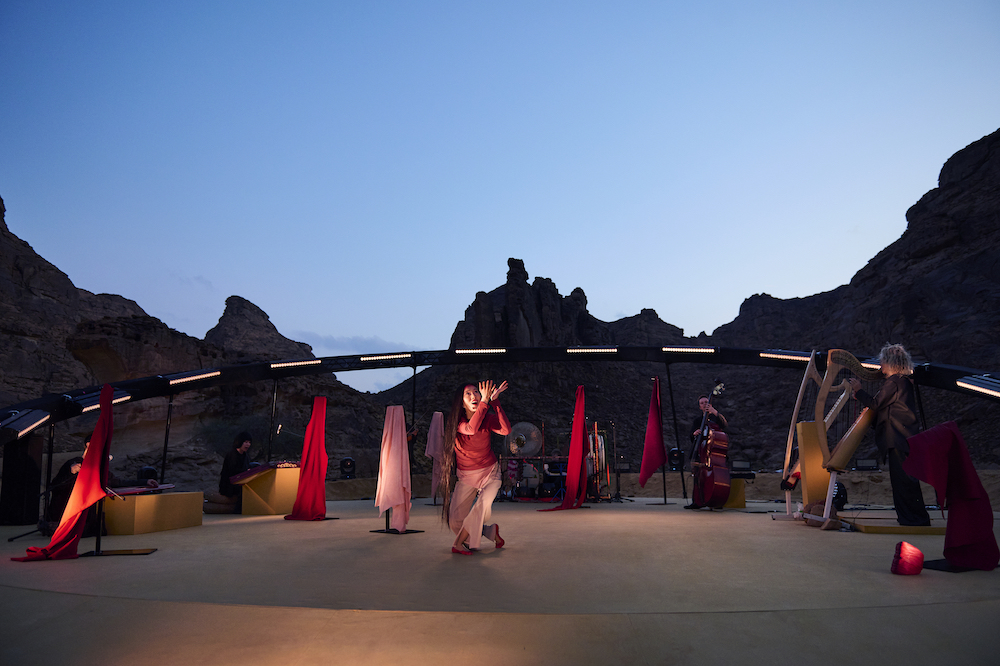 World premiere of Nine Songs, presented by Wadi AlFann, courtesy of Royal Commission for AlUla.
World premiere of Nine Songs, presented by Wadi AlFann, courtesy of Royal Commission for AlUla.
WW: Will the element of sound contribute to the Wadi AlFan experience outside of this performance?
IB: Yes. There’s a very interesting cosmos of life here but, it’s skittish. It’s invisible at some times of day, and to really enjoy it you have to be quiet, walk, listen, and look. That’s something I think our commissions will encourage people to do.
In particular, James Turrell’s “Sky Chambers” ask that you sit and look, and make a journey inside his chamber, taking you out of the world for a moment. He plunges you into darkness, you emerge in a chamber and look up as he frames the sky, and suddenly, something that we take no notice of becomes the sublime. It’s a very intense experience of time itself.
That mindfulness is what everything we’re doing is moving towards. Having an awareness of this epic, gigantic place, and its many marvels. A place that can’t be conquered, that is fragile in many ways, and is much bigger than us. And I think that appreciation of the sublime nature of the desert is implicit in many of the works we’ve commissioned.
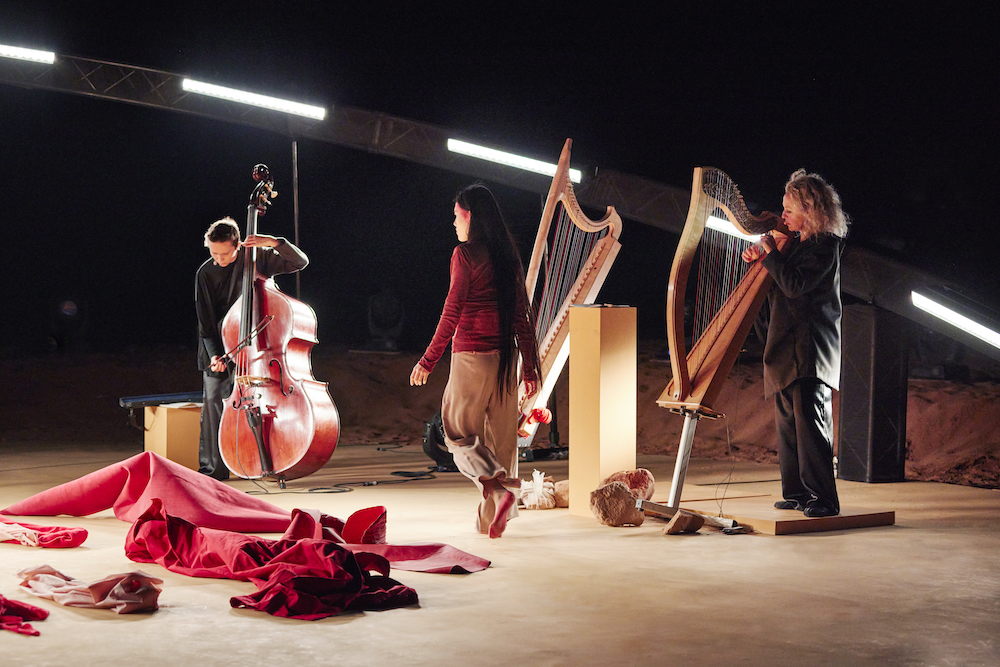 World premiere of Nine Songs, presented by Wadi AlFann, courtesy of Royal Commission for AlUla.
World premiere of Nine Songs, presented by Wadi AlFann, courtesy of Royal Commission for AlUla.
WW: Turrell is one of the five artists commissioned to create works, alongside Denes, AlDowayan, Mater, and Heizer. How were the artists selected?
IB: To start with Agnes, there’s an extraordinary photograph of her standing in a wheat field right next to the Twin Towers in New York with a pitchfork. She’s always counterpointing nature, stressing the importance of it to a humanity who constantly tries to destroy it, exploit it. Her work is about reconnecting us with something fundamental. At the same time, she is drawn to geometry, and to the pyramid as a form. She’s interested in it because it’s such an ancient preoccupation in human civilization. It points upwards to the cosmos, like a connection between the celestial and the earth. It’s also used in a way that isn’t functional. If you think about the pyramids, they are monuments, not buildings. She takes that form, and incises it into the walls of a canyon, echoing the hieroglyphs everywhere to be found in the desert. So, her work is about connecting with something very elemental, while bringing geometry and a kind of minimalism.
Manal Al Dowayan, by contrast, is a Saudi, 21st-century artist, very interested in the local communities. There are many kinds of habitats in the desert, some are settlements, some nomadic, she looks at the ancient settlement of AlUla itself, which is 900 years old. A labyrinth scene, almost like a beehive, it was abandoned in the 1980s and is now a heritage site, which if you look down on reveals an amazing structure. She’s making a kind of doppelganger of that, recreating a section of it in the desert, while also collecting stories, and narratives of people who lived there, incising them on the walls of the structure. So, what we’ll hear are the ghosts, the memories, and the whispers of what life was like so that we encounter them as we explore this kind of architectonic sculpture.
Michael Heizer draws on his experience as a child. His father was an archaeologist looking at petroglyphs, and he will be carving them in the canyon elsewhere in the site. He’s going back to the most ancient form of human mark-making, realizing it at an enormous scale. There’s a lightness of touch there because compared to City, his work in Nevada consisting of huge volumes on a massive scale, it is different in that it doesn’t have a material form, but rather consists of a series of lines taken out of a form that exists already.
As for Ahmed Matter, his reference is more mythological and cultural. It’s related to the natural phenomenon in the desert of the mirage. He is creating an oculus in the desert floor below the desert floor, the subterranean, that you’ll enter. And then, anyone on the outside of the Oculus will see a mirage. They’ll see a figure floating in the desert. Very extraordinary work. He’s tapping into the poetic literary references of the mirage, but also the symbolic, which is of wishful fulfillment, this idea of the destination we long for. And for him, the mirage has to do with the way the country is moving towards a new ideal.
Turrell will be creating three “Sky Chambers.” He will invite us to enter a mountain, walk through a tunnel, and emerge in a sky chamber, creating a framing of the sky, in which at sunrise and sunset, will occur the most dramatic light changes. We’ll see gradual crepuscular change, moving from black to indigo, or maroon to pink, to blue, or vice versa to yellow. And, the little epiphenomena. A bird, a flight of birds, a cloud, the odd plane. A complete surrender to the atmosphere and the silence, and the enormity of this place.
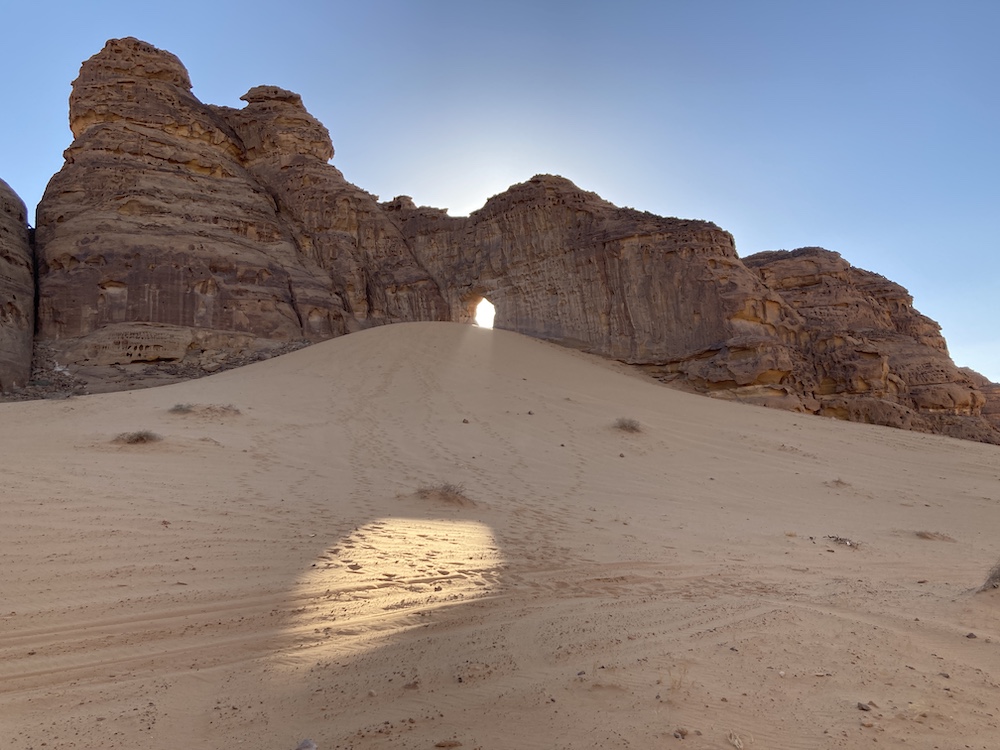 Wadi AlFann, AlUla, courtesy of the Royal Commission for AlUla.
Wadi AlFann, AlUla, courtesy of the Royal Commission for AlUla.
WW: What were some of the surprising elements and themes you witness emerge as these artists conceived works inspired by the desert?
IB: The diversity of approach and also, the research process. Heizer is absolutely fascinated by geology, whereas Manal is really interested in people, in storytelling. Ahmed, trained as a doctor, is interested in optics. He’s influenced by Arabic philosophy, and the physicists who discovered that we don’t see images with our eyes, but our brains. He is very interested in the nature of perception.
For me, the most important sculptor of the desert is the wind. When you see the profiles that the sun and wind have created, it’s extraordinary. It’s like an enormous sculpture garden already. There are silhouettes of people, animals, surfaces of rocks almost like pre-configurations of calligraphy in the filigree nature of the sandstone facades, all thrilling to walk and discover through the terrain.
WW: AlUla’s landscape has been shaped by the forces of geology and climate, raising mountains, and shifting its sands, constantly changing, and evolving under the planet’s most powerful sculptor, the wind. Will these forces be considered in the curation of permanent works? Were the artists forethoughtful of erosion in their choice of materials? What guidelines or briefs were they handed?
IB: They have to create things that are going to be there for a hundred years, that’s the challenge. It’s a very harsh environment. The heat, the wind, the animals, it’s really demanding for sculpture. So, we have very clear criteria.
We’re also keen to minimize our carbon footprint and ask artists to use materials sourced from a hundred-mile radius while involving the local community. It’s incredibly important to us that they feel it’s their place and feel a connection with the works as much as the historical monuments. We want us all to be part of one community, and ask artists to give masterclasses, etc. We want people in AlUla to be part of the making of works.
Manal Al Dowayan is already embarking on that, and we’re hoping that future artists from AlUla will be making works here. It’s a project with high ideals, perhaps rather utopian, very mindful of treading as lightly as possible, minimizing our impact as we celebrate its beauty.
WW: A crossroads of ancient civilizations, how does the curation of Wadi Al Fann reflect the abundant cultural exchange that marks the region’s history?
IB: By bringing the world to AlUla. In the past, the international art world has been very western. It believed modernism was a western construct, but it isn’t. Now, it’s acknowledged that there have been multiple modernisms and that there’s been great art made all over the planet. So, what we will be seeing is artists from the global south being given equal resources and standing.
We’re also very committed to gender parity and, can lead to being truly global with artists from everywhere from South Asia to Latin America, Africa, and of course, the Middle East, which is incredibly rich in creativity. That in itself is surprising if you consider how difficult life has been there over the last hundred years. Colonization, civil war, displacement, it’s just been devastating. So many artists suffered incarceration, censorship, forced to leave their countries through civil war and conflict, and yet, they continue to make great art. It’s really moving to acknowledge that, and to put it on the world stage, I think for the first time.
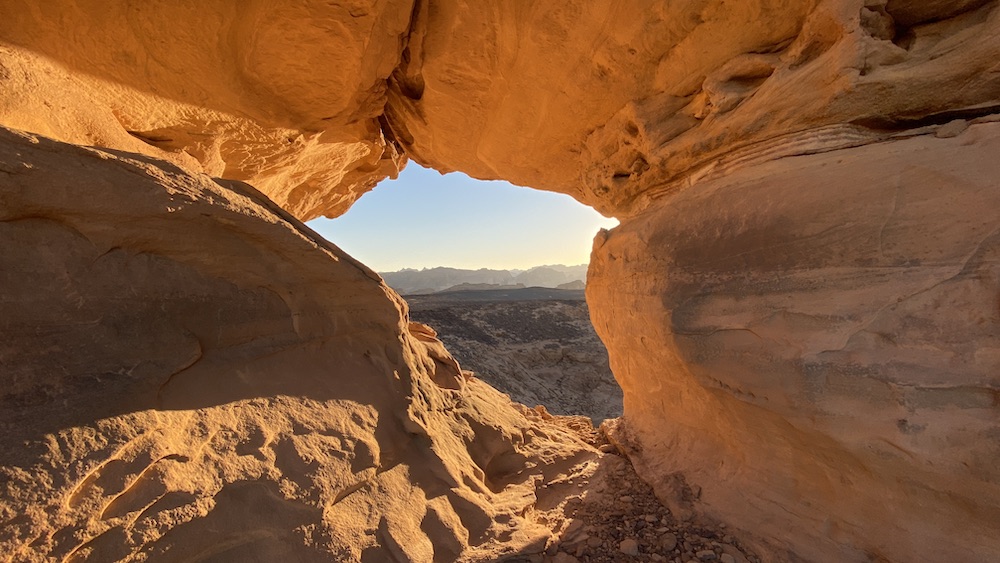 Wadi AlFann, AlUla, courtesy of the Royal Commission for AlUla.
Wadi AlFann, AlUla, courtesy of the Royal Commission for AlUla.
WW: The unveiling of the first five artworks in 2024 will mark the start of a continued program of commissions, with more artists and activities to come. Can you give us insight on what we can expect in the coming years?
IB: We’re hoping that by 2030 we will have up to 20 major works there. A reflection in AlUla of what’s happening in the wider art world. There’s been a huge emphasis on identity over the last few years, and Manal’s work really locks into that. She talks about invisible identities like the women of Saudi Arabia. So, it will be a reflection, I think, and a synthesis of wider tendencies.
Performance is also something that we really want to develop. Commissioning new works from dancers, musicians, live artists, and poets that would respond to the works of art, and, in the same way as “Nine Songs,” forge works made in response to the sculptures that interact with them in some way.
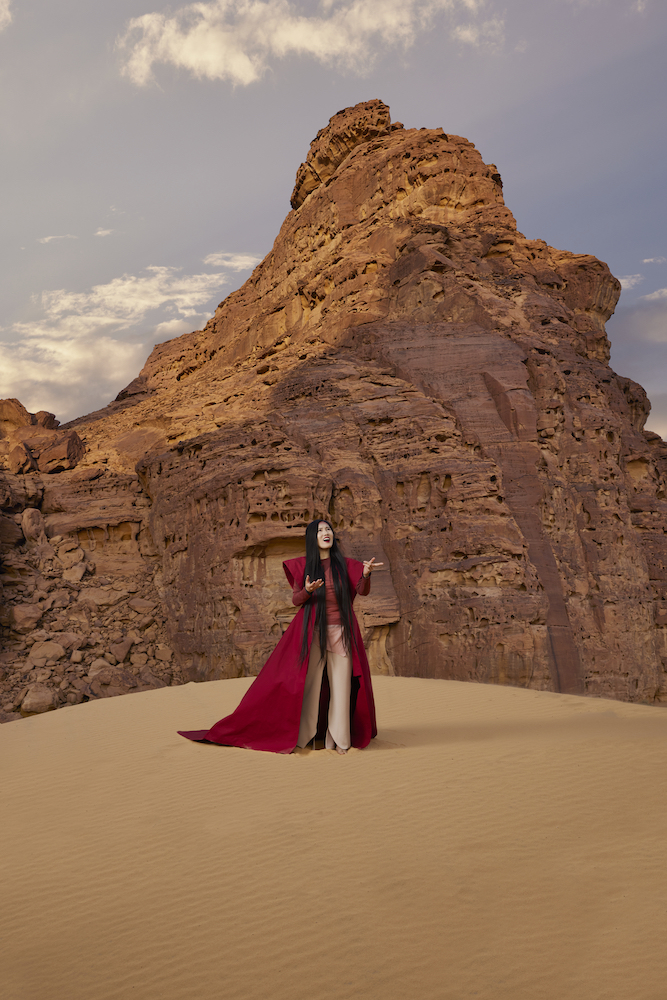 Vocalist Rui Fu in Nine Songs, presented by Wadi AlFann (Image courtesy of Royal Commission for AlUla, photography by Alto Piano Studio).
Vocalist Rui Fu in Nine Songs, presented by Wadi AlFann (Image courtesy of Royal Commission for AlUla, photography by Alto Piano Studio).






